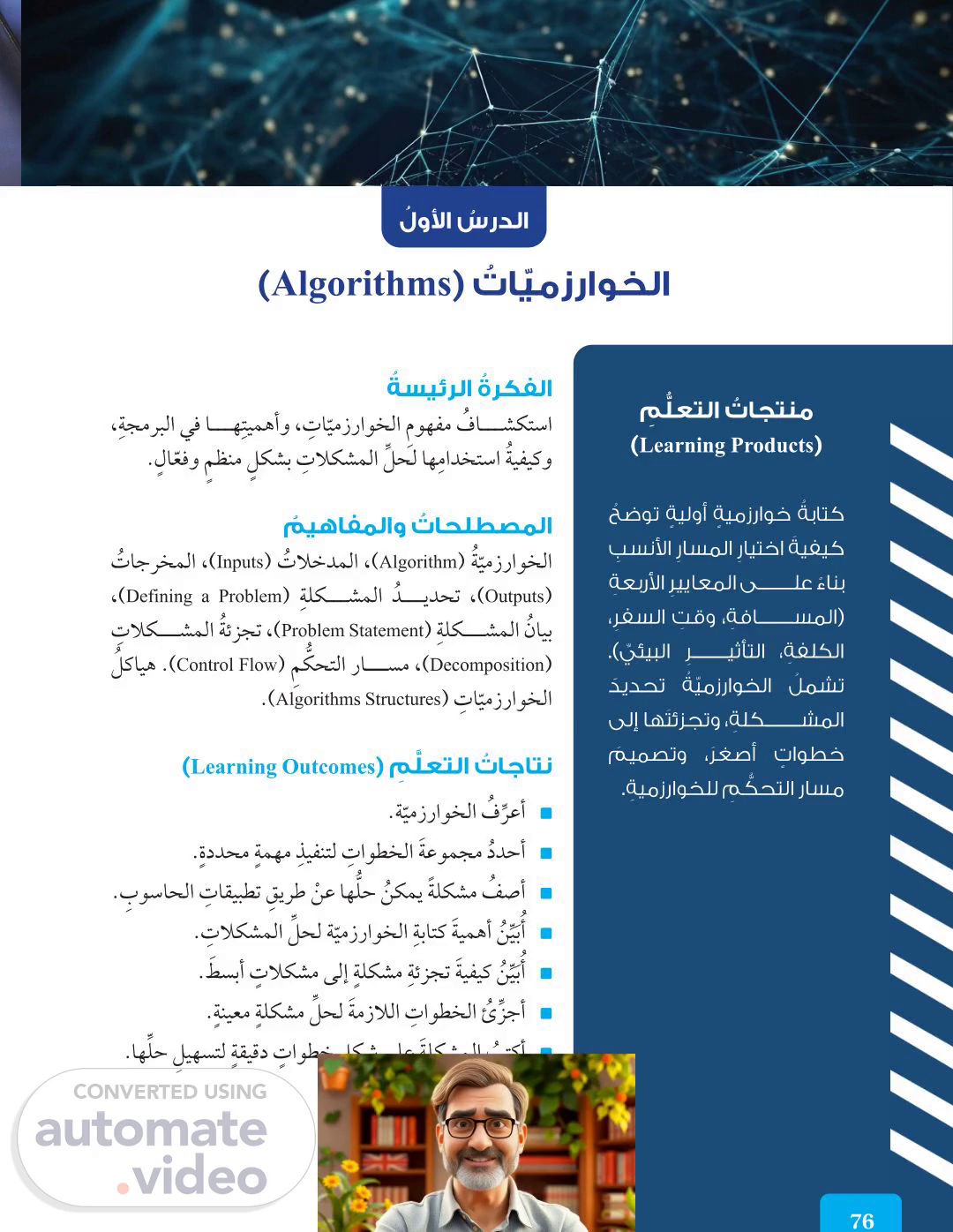Scene 1 (0s)
OJJXJI (Algorithms) 04.0jJ19AJI 4.ue3JJl O.S.A.II to-LR.iJl (Learning Products) æ-Jgi d4-ojJlg-5 QQILS 64.01."0.119 él.a.l.h.z.o.ll JLu.LoJl JliL51 '(Inpllts) ds-JJiJl IS-OJI ÉLiJ. ,J-O-uDl c:.Lög J—L3bJI ,ä-åLSJl Qi.ojJlgAJl 10 Iffi (Algorithms Structures) OJ! I oYifijÄjg rou-o-Ajg ülgh-5 (Le»rnjng Outcomes) CJL*ti.j .ti.! ojJlg-±LLJ ru-SniJl JLn.Lo 76.
Scene 2 (34s)
b LdÜ 77 uu.ojJ19ÄJI.
Scene 3 (40s)
[Audio] Learning algorithms can be complex and multifaceted, but they also have the potential to greatly impact our understanding of the world around us. By examining the relationships between different variables, we can gain valuable insights into how systems function and interact. For example, consider the concept of correlation versus causation - while these two ideas may seem similar on the surface, they have distinct implications for our understanding of the world. Correlation refers to the statistical relationship between two or more variables, whereas causation implies a direct cause-and-effect relationship between those same variables. Understanding this distinction is crucial for making informed decisions about the world around us. As we delve deeper into the world of learning algorithms, it becomes clear that the relationships between variables are not always straightforward. There may be hidden patterns or biases that can affect the accuracy of our conclusions. Therefore, it is essential to approach these algorithms with a critical eye, recognizing both their strengths and limitations..
Scene 4 (1m 48s)
[Audio] Learning algorithms and products have been developed to assist us in our educational journey. One such product is Google Docs, which has revolutionized the way we collaborate and share information. With its user-friendly interface and real-time updates, it has become an essential tool for students and teachers alike. The benefits of using Google Docs include improved communication, enhanced collaboration, and increased productivity. By leveraging this technology, we can create a more engaging and interactive learning experience..
Scene 5 (2m 22s)
[Audio] Learning algorithms can be complex and nuanced, but they also have the potential to greatly impact our understanding of data and the world around us. One example of this is Google Docs, which uses machine learning algorithms to help users collaborate and edit documents more efficiently. This technology has been shown to improve communication and reduce errors, making it a valuable tool for students and professionals alike. By leveraging these algorithms, we can create more effective and efficient systems for learning and productivity..
Scene 6 (2m 58s)
[Audio] When we are trying to solve a problem, it is essential to define it clearly. This step is crucial because it helps us understand what we are dealing with and what we need to achieve. By defining the problem, we can identify the key issues and determine the scope of our solution. It is like having a roadmap that guides us through the process. Without a clear definition of the problem, we risk wasting time and resources on solutions that may not even address the issue. So, let's take the time to get this right and set ourselves up for success..
Scene 7 (3m 31s)
(1) dlå.o 82.
Scene 8 (3m 37s)
[Audio] Learning algorithms and products have been designed to help us understand and analyze data more effectively. These tools can process large amounts of information quickly and accurately, allowing us to identify patterns and trends that might not be immediately apparent. For instance, machine learning algorithms can be utilized to forecast customer behavior, optimize business procedures, and even diagnose medical conditions. The framework of these algorithms is typically grounded in mathematical models and statistical methods, which enable them to learn from data and enhance their performance over time. The consequences of utilizing these algorithms and products can be substantial, encompassing increased efficiency, improved decision-making, and advanced insights into intricate systems..
Scene 9 (4m 30s)
I äJüS b 84.
Scene 10 (4m 36s)
[Audio] Learning algorithms and products have been designed to simplify complex tasks and improve our understanding of the world around us. One such product is Deeompoge, which has been developed to decompose and simplify large problems into manageable parts. This approach allows us to break down complex issues into smaller, more understandable components, making it easier to analyze and solve them. With Deeompoge, we can identify patterns and relationships between different elements, leading to new insights and discoveries. By using this tool, we can streamline our thinking and focus on the most critical aspects of a problem, ultimately leading to better outcomes..
Scene 11 (5m 20s)
[Audio] Learning algorithms and products have been designed to facilitate efficient processing and analysis of data. These tools enable us to extract valuable insights from large datasets, making it possible to identify patterns and trends that might not be apparent through manual examination alone. The outcome of using these algorithms and products can be significant, allowing us to make informed decisions and drive meaningful change in our respective fields. For instance, machine learning models can predict customer behavior, enabling businesses to tailor their marketing strategies accordingly. Similarly, natural language processing techniques can help analyze vast amounts of text data, uncovering hidden relationships and sentiments. By leveraging these technologies, we can unlock new opportunities for growth, innovation, and improvement..
